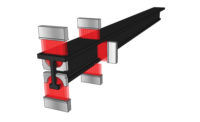NDT | Trends
Monitoring Assets with Restricted Access Phased Array
Corrosion is complex, and mitigating and managing it is not a linear process.

Source: ALS Global
Across just about all industries that have tanks, piping upon supports or piping entering the ground, clients are faced with inspection challenges and specific concerns on how to inspect the critical areas of these three asset components. The Restricted Access Phased Array (RAPA) method, however, can inspect these traditionally challenging areas, which have been historically known for having no easy inspection solutions.
RAPA is an ultrasonic testing method which is a powerful corrosion screening tool. The RAPA benefits lie in the significantly reduced inspection time, limited excavation demands and the ability to potentially extend intervals for tank inspection, or prioritize tank inspections.
 Source: ALS Global
Source: ALS Global
RAPA FOR TANKS
Tank inspections are a necessity for a myriad of reasons – from compliance to a variety to regulatory standards, through to the ongoing detection and maintenance of concerns such as corrosion and leaks. Left unchecked, tanks can become a major safety and environmental concern with the potential for catastrophic consequences a genuine possibility.
Yet, tank inspections are not a straightforward process as many zones on a tank need specific inspection techniques used or specific concerns screened for. One zone that falls under this complex category is the annular rings in above ground storage tanks, which is the area under the outer perimeter of the base. As a corrosion hotspot, these annular rings and their welding joints are prone to accelerated underside corrosion given the considerable mechanical stress placed on this region. In addition, if there is internal topside corrosion in the critical zone, it could make this region even weaker.
While traditionally inspecting these annular tank rings has required an offline inspection, the Restricted Access Phased Array (RAPA) screening inspection allows tanks to remain in-service throughout an inspection.
RAPA is an advanced nondestructive testing technique proven as an effective short distance, corrosion scanning solution. The benefit of adopting RAPA scanning for annular tanks is two-fold – one, tanks can remain in-service, eliminating a major inspection limitation. Secondly, with RAPA clients can gain a better understanding of the integrity of their tanks at the critical zone.
By adopting RAPA inspection screening when a tank is in-service, operators are able to understand any potential threats to the tank’s structural integrity and prioritize future inspections accordingly. This ability to foresee threats makes RAPA inspection an effective pre-shutdown strategy for many clients wanting to allocate inspection spend to where most needed.
When it comes to safeguarding a tank’s safety and integrity, RAPA has proven a powerful inspection approach to scanning a tank’s annular plates, and providing an “early warning.” Like any inspection technique however, adopting RAPA scanning to annular plates does require some consideration. Such considerations include cleaning annular tanks to bare metal in order to eliminate a method variable and improve signal transmission. Further considerations include the annular protrusion which should be 40mm or greater, and should not be heavily corroded either on the topside or underside.
The tank inspections priority is to minimize disruption and safeguard production without any quality trade-offs. RAPA is one advanced inspection approach helping to achieve such results. Using RAPA to scan annular tank rings, inspections can be performed with minimal disruption and optimized outcomes.
 Source: ALS Global
Source: ALS Global
RAPA FOR PIPING UPON SUPPORTS
All piping sits on some form of support and hence all piping can be susceptible to wear through movement during operation or from a build-up of debris under the pipe corrosion that can occur. This applies to lagged and un-lagged piping.
In the past the only way to inspect these areas was to either do a limited visual inspection or alternatively lift the pipe, which is a safety hazard and financially intensive process. The process of lifting piping for a visual inspection is rigorous and some piping configurations are unable to be lifted.
With the RAPA method ALS can now screen the area under the piping where it sits on the support and determine the presence of damage, resulting in a more focused understanding of CUPS. Ultimately, this improves safety and significantly reduces financial demands.
RAPA FOR PIPING ENTERING THE GROUND
Up to one meter below the surface of the ground, the make-up of moisture and oxygen is an ideal environment to corrode carbon steel piping. Traditionally, the only way to inspect this area of piping was to excavate a hole around the pipe for visual inspection.
The issue with this excavation inspection method is that only the piping presenting evidence of corrosion actually requires excavation. In adopting a RAPA inspection screening, the safety concerns associated with an excavation are eliminated and inspection spend is significantly reduced, by targeting an excavation only where there is evidence of corrosion below the ground.
Overall, RAPA eliminates the potential scenario of digging a hole only to find the pipe work is in good condition.
Corrosion is complex, and mitigating and managing it is not a linear process. That being said, RAPA has made inspecting these three traditionally problematic locations increasingly feasible. For all three of the above applications, RAPA is used as a cost-effective screening tool to elevate safety and spend inspection budget funds in a more focused manner. The screening solution is considered increasingly valuable when used as the preliminary inspection approach – used to guide further inspection and pinpoint required remedial action.
Looking for a reprint of this article?
From high-res PDFs to custom plaques, order your copy today!




